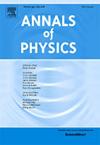具有Durgapal-Fuloria度量势的重力星模型
IF 3
3区 物理与天体物理
Q2 PHYSICS, MULTIDISCIPLINARY
引用次数: 0
摘要
在本研究中,我们利用Durgapal-Fuloria度量势在(3+1)维框架中提出了一种新的重力星模型,作为黑洞理论的可行替代模型,该模型克服了中心奇点和视界问题。Mazur和Motolla(M-M)通过研究引力系统中的玻色-爱因斯坦凝聚,提出了引力真空凝聚星(gravastar)的概念。gravastar解具有内部de-Sitter时空和外部Schwarzschild时空的特征。薄薄的外壳将de-Sitter内部与外部区域分开。利用Durgapal-Fuloria度量势,确定了内部和壳区的其他度量势,消除了奇异性。我们研究了由超相对论等离子体组成的壳区,发现它们的固有长度、能量和熵随着厚度的增加而增加。此外,我们还分析了与内外时空相匹配的结条件,观察到表面能密度和表面压力随厚度的增加而减小。通过对声速的分析,预测了重力星模型的稳定性。因此,我们的结果产生了一个完整的引力星精确解族,这些解不仅是非奇异的,而且是稳定的。本文章由计算机程序翻译,如有差异,请以英文原文为准。
A gravastar model with Durgapal—Fuloria metric potential
In this present work, we have proposed a novel gravastar model as a viable alternative model to the black hole(BH) theory by using the Durgapal-Fuloria metric potential in a dimensional framework which overcomes the central singularity and event horizon problem. Mazur and Motolla(M-M) introduced the idea of gravitational vacuum condensate star(gravastar) by studying the Bose–Einstein condensation in the gravitational systems. The gravastar solution featured an interior de-Sitter spacetime along with an external Schwarzschild space–time. A thin shell separates the de-Sitter interior from the exterior region. By utilizing the Durgapal-Fuloria metric potential, the other metric potential in the interior and the shell region have been determined that eliminates the singularity. We have examined the shell region comprising of ultra-relativistic plasma such as proper length, energy and entropy and they are found to be increasing with increasing thickness. Furthermore, we have analyzed the junction conditions that match the interior and the exterior spacetimes, it is observed that the surface energy density and surface pressure are decreasing with increasing thickness. The analysis of speed of sound predicts the stability of the gravastar model. Thus our results yield a complete family of exact solutions for the gravatsar, which are not only non-singular but also stable.
求助全文
通过发布文献求助,成功后即可免费获取论文全文。
去求助
来源期刊

Annals of Physics
物理-物理:综合
CiteScore
5.30
自引率
3.30%
发文量
211
审稿时长
47 days
期刊介绍:
Annals of Physics presents original work in all areas of basic theoretic physics research. Ideas are developed and fully explored, and thorough treatment is given to first principles and ultimate applications. Annals of Physics emphasizes clarity and intelligibility in the articles it publishes, thus making them as accessible as possible. Readers familiar with recent developments in the field are provided with sufficient detail and background to follow the arguments and understand their significance.
The Editors of the journal cover all fields of theoretical physics. Articles published in the journal are typically longer than 20 pages.
 求助内容:
求助内容: 应助结果提醒方式:
应助结果提醒方式:


